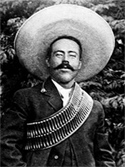A Selfie
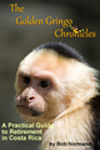 |
If you would like to read a version of
the Golden Gringo Chronicles
in a narrative format,
as a hard-copy novel
or an e-book
check it out HERE
Broken News
(All the News That's Fit to Reprint)
Nica Canal Problems
The Chronicles has been following the Nicaraguan government's plan to finance and build a major canal across the middle of the country from the Caribbean to the Pacific. In June 2013, the Nicaraguan government granted a 50-year concession to HKND Investment Group, a Hong Kong company, controlled by Chinese billionaire Wang Jing, and who are also to provide the funding.
The project was stopped once in 2014, ostensibly for technical reasons, then restarted. The cost estimate originally was set at $30 billion and rose to $50 billion within two years (does anyone believe it won't hit closer to $100 billion if and when it's done?). There has been little concern (at least in the government) in Nicaragua that this project, even at $50 billion, would cost four times the total GDP of Nicaragua or create a giant swath of disruption through the countryside, including cleaving two major environmental reserve areas and running ships through a major fresh water source for Central America (Lake Nicaragua) that also services Costa Rica by aquifer.
Lake Nicaragua Now
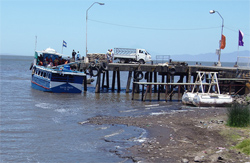 |
The government continues to publicly state that the project is ongoing but a recent IPS (Inter Press Service) report says that physical activity on the project has recently stopped for two reasons: 1) a severe drought in Nicaragua this year has made the giant Lake Nicaragua un-navigable for small boats let alone ships (see photo left) and 2) severe money problems at Wang Jing's HKND, aggravated by the Chinese stock market collapse. One report says that HKND's market cap has shrunk to as low as 10% of it's value only a couple of years ago, greatly reducing it's borrowing power.
While the Nica government continues to say the project is full steam ahead, reporters have noticed a recent cessation of physical activity along the 276 km (165 mile) route. Is it stopped or just paused?
GGC will continue to follow this remarkable project until it resolves itself one way or another. For more background on the Nica Canal, go here:
Danny's Ditch - Edition 48
The Chino-Nica Ditch - Edition 51
Nica Canal Update - Edition 59
Last of the Cubans Leave
You may have been following the plight of the 8,000+ cubans who got hung up recently in Costa Rica when Nicaragua refused to participate in the equivalent of an underground railroad designed to spirit the emigres from Ecuador to the U.S. border through Central America and Mexico (see Porous Perimeters).
El President Solis (Dark Blue Shirt Center) and
the
Last of the Cubans
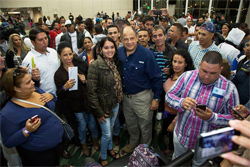 |
After a lot of discussion, the key countries involved (sans Nicaragua) came to an agreement to spirit the refugees via air to Guatemala, Honduras and, later, directly to Mexico. Not all 8,000+ were handled in this way as some chose not to wait for resolution of the problem and opted to go with Plan A, that is, hiring coyotes to take them across borders illegally. But airlines contracted by the Costa Rican government did take several thousand of the Cubans to countries beyond Nicaragua and, later, directly to Mexico.
Recent press reports showed Costa Rican president Solis personally showing up at Juan Santamaria airport to say goodbye to the last of this group. Hopefully this is the end to the current crisis at least. In the meantime the government here also made it clear that, in the future, Cubans would not be allowed to enter the country without a valid visa issued from the Costa Rican embassy in Havana nor would any 7-day transit visas be issued.
...Update: Wait a Minute, It's Not Over:
Immigrants Crossing Paso Canoas
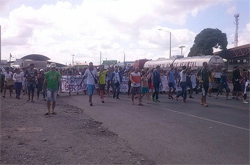 |
13 April. All of a sudden (Really? Is there no one watching out for these things?) on the morning of April 13, some 700 people comprised of Cubans and Africans and other foreigners, all without valid visas, just came walking en masse across the border at Paso Canoas, on the Pacific side of the border between Panama and Costa Rica. If you have ever been there (GG has, four times during the gotta-renew-the-passport-visa-every-90-days period of his existence here), you know that particular border point is quite open and vulnerable to a large group of people assaulted it that way.
The police were overwhelmed. Some rioting occurred and several cars were damaged. By the end of the day additional police were reinforcing the local authorities and some of the invaders were being detained in towns as far north as Cuidad Neily (18 km/11 miles). Hundreds more Cubans are reported detained in San Isidro (that's over 200 km from Paso Canoas - where did they come from - perhaps the San Vito crossover which is directly south of San Isidro?).
Africans Rounded-Up and Being Held at Panama Border
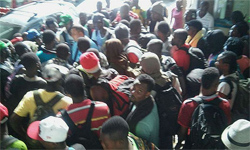 |
Panama was busy reinforcing its border forces (so how did they get into your country in the first place amigos?) and Nicaragua was sending more troops to reinforce its southern borders with Costa Rica, particularly the new one at Las Tablillas. That kind of leaves the illegals bottled up in Costa Rica. Costa Rican president Solis fired off a letter to Barack Obama blaming the problem on the Cuban Adjustment Act of the 1960s "that grants them (Cubans - ed.) instant entry into the United States by land" and telling him Costa Rica does not have the resources to handle this problem.
Africans Protesting
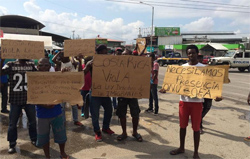 |
15 April. Press reports said 220 Africans also were reported rounded up in Costa Rica and were being shipped back (deported) to the Panama border where that country refused to take them back. The Africans were then in "no-man's land". The government continued on their plan to deport them but the method became unclear. In the meantime the Africans held a peaceful protest (right). (At last, I found someone who uses Spanish worse than me: "Necesilamos...")
Other reports said there were thousands of Cubans in Panama backed up and hoping to get to Mexico via Central American countries, just like the original 8,000. Reportedly, Panama wants no part of their return, leaving Costa Rica stuck again should they get across the border by coyote or some other way.
Stay tuned.
Fire Season
Guanacaste in April
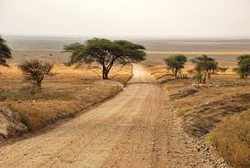 |
When you think of Costa Rica most people will conjure up visions of green mountains with cool air and dark, lush, tropical, humid jungles. We have all of that but we also have a dry season and this year it's been a very dry season. Typically the dry season runs from late December until late April, sometimes through May. The hottest temperature and driest month of the year is in April (see Singing in the Rain for temperature and rain stats by month for Costa Rica as compared to Florida and Boston). While the central and south Pacific coasts tend to stay green (like Quepos/Manuel Antonio), other parts of Costa Rica, particularly the northwest, do not.
Night Wildfire - Guanacaste
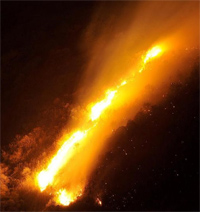 |
This year, the hotter, drier season has been reinforced by a strong El Nino effect that has produced drought conditions all across Central America (as well, I take it, as it has in the western U.S.). In Costa Rica, the northwest quadrant of the country, mostly in Guanacaste and Alejuela provinces, has been especially dry. The dryness of Guanacaste province continues over the Nicaragua border going north in a wide wedge of land bordered by the Pacific on the west and Lake Nicaragua on the east and continuing almost up to Managua. The level of the lake has been seriously drawn down as mentioned in the article on the Nica canal above.
Dust Funnel
in Alejuela Province
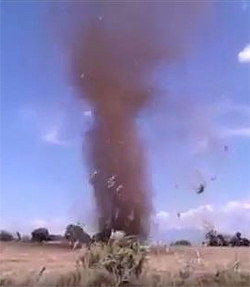 |
Wildfires have popped up in several places in Ticoland, started by lightening or carelessness, and have been particularly bad along the Costa Rica/Nicaragua border area. At press time, some of the fires had consumed a total of almost 2,000 hectares (5,000 acres) in several locations.
Our "Bomberos" have been busy this year (see What's-in-a-Word below for this word). Brush and forest fires have damaged communication lines, including ruptured fiber optic cables, cell towers and fixed telephone lines in Guanacaste and the Nicoya peninsula.
Then there's the dust. The dry area in the northwest quadrant is known for it's strong winds, called "papagayos" (see What's-in-a-Word section below for an explanation of this term) and they can whip up the dust into something that resembles a tornado funnel seen in the United States, often called a Dust Devil. Someone recently snapped the photo of a dust funnel that popped up in Alejuela province recently and it's shown to the left.
When the rains finally hit, all this dry brownness will quickly become history once more. As a friend in Nicaragua once said: "Bob, when the rain comes, it's like God took a great paint brush and painted green all over the countryside".
We're all ready for that amigo, come on Big Dude, do your thing!
Diabetes Drug or Fountain of Youth?
 An interesting report came out recently about Metformin, a drug used to control sugar level in Type II diabetics like yours truly.
An interesting report came out recently about Metformin, a drug used to control sugar level in Type II diabetics like yours truly.
GG takes two 500 mg Metformina (local name) pills each day (2-500mg = 1000mg = 1gram = 1/454th of a pound = .035 oz, not much, eh?) and I am happy to report that at my last checkup in March, dear old Doctor Mojarro reported my latest blood test showed that GG's sugar level was only very slightly higher than normal; he gave me an A grade on the sugar level and everything else. Pura vida!
Metformin has been prescribed for Type II diabetes patients for over 50 years giving medical personnel plenty of time to observe side effects. One of the things that was gradually noticed about people taking the drug was an apparently lower incidence in age related diseases that shorten life span and even a lower incidence of cancer. One researcher from Harvard Medical School was so bold as to put it this way: "Metformin may have already saved more people from cancer deaths than any drug in history.”
Chemical Formula for Metformin
 |
As there now is enough interest and cursory evidence in the possibility of Metformin being a kind of "fountain of youth" the U.S. FDA has approved a double-blind, placebo-controlled study on about 3,000 elderly people who "either suffer from or have a high risk of developing diseases like cancer, heart disease, or cognitive problems (I have the cognitive thing with Metformina - ed.)". The study will track the test group's experiences over a period of six years.
Evidently one of the things Metformin does is increase the release of oxygen into cells. Being a crusty old chemical engineer, that mechanism interested me and I looked up the chemical formula (above, right). There's no oxygen in the chemical itself so, if the claimed oxygen enrichment occurs, perhaps all that nitrogen, of which there is mucho, draws O2 from somewhere else. I could not help but think that if, in the chemical/biological process, the nitrogen temporarily combines with the oxygen, nitrous oxide would be produced, which is also known as laughing gas. Happy people live longer, right? Just a theory amigos, not yet ready for the American Journal of Science. (Once a Chem E always a Chem E)
Ha, ha, ha, ha, ha, ha, ha, ha, ha, ha, ha, ha, ha, ha, ha, ha, ha, ha, ha, ha, ha, ha, ha, ha, ha!!!
Costa Rica Birth Rate Drops
Median Age in Costa Rica by Year
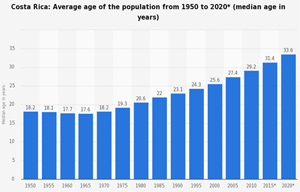 |
One of the interesting data points I came across after moving here in 2008 was the fact that the median age of a person in Costa Rica was about 28 while in the U.S. it was just about 10 years older at 37.8. But look at the chart to the left. The average age here has increased rapidly in recent years. It's currently over 32 and is expected to be almost 34 by 2020 (while the average U.S. age grows much more slowly), wiping out 60% of the average age difference between the two countries in 2008.
The other interesting thing about that chart is that the median age in Costa Rica was actually less than 18 in the 1960's(!). One of the things that contributes to an older average age is not only people living longer but also a change in the demographic which includes a drop in the birth rate. Twenty years ago the birth rate here per 1,000 inhabitants was 24, now it's 15, a drop of 38%.
A rapidly aging population means a greatly different citizen profile as well as a likely increase in medical problems and cost of care for the government national health system. The major health problems here are not the Dengue or Zika viruses, although they're both present and dangerous. Obesity and diabetes, products of an affluent and aging demographic, have become the major problems to contend with and hardly a day goes by without the press covering some aspect of that "epidemic". Of course this also strains the financial resources of a government already running a 50% annual budget deficit.
Better keep the metformin coming amigos, it's cheap and it looks like more and more people will need it.
Quepos Quickies
Last of the One-Lane Bridges. When the golden one moved to Costa Rica in 2008 there were 11 one-lane bridges between downtown Quepos and Juan Santamaria airport in San José. I know, I negotiated all of them a half dozen or more times during the early days and before the roads were improved.
View from a Ridge Near Atenas
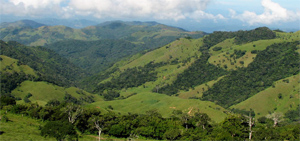 |
In January, 2010 the autopista between Orotina and San José. opened, eliminating the need to go over the mountain road to get to the airport and eliminating the opportunity to use several of those one-laners. Actually, you can still go to the airport over that route and the road still has at least three of the one-laners but most people don't go that way because it's a bit slower (30-45 mins?) and a stronger driving challenge. Several times in the last few years GG has purposely used the old route coming west and south from the airport to show guests the magnificent vista from the top of those mountains - outstanding.
Last One-Laner Coming Into Quepos
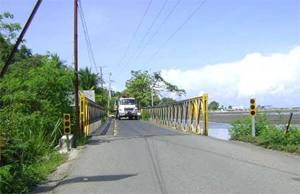 |
In the next few years after the autopista was opened, all the main route one-lane bridges in the Quepos area (Parrita, Paquita, even one in the La Bomba section of Quepos) were upgraded.
After that we were down to one single-lane bridge, the bailey bridge shown at right which empties from Boca Vieja into downtown Quepos near the Malecón.
Yes, the bridge requires vehicles to often back up in both directions during the day and evening; yes a two lane bridge will improve traffic flow and, I assume with that, safety will also improve, but damn, I hate to see all this heritage disappear. And I give no apology for being a nostalgic old coot, pshaw!
While the new bridge is being constructed, traffic really has only two routes to get to downtown. Either you have to take the main highway south of the town (Costanera Sur) and pick up the road to Quepos or one cuts into the north side of town using a narrow street about a quarter mile before the current bridge. The problem with that last one is it contains another one-laner (absolutely last one in town?) where the vehicle approaches on both sides are narrow and short.
The project is expected to take several months. Take a deep breath, GG, they call this progress.
Addendum. FYI. A bus trip to San José. in late April confirmed that the new temporary route for busses leaving and entering Quepos will be the Costanera Sur diversion, the bus driver stating that the little one-laner bridge in Boca Vieja is not only very difficult to negotiate but does not have a capacity rating to carry the weight of a bus. The detour added 15-20 mins to the overall trip.
JW's to the Rescue. GG got off the Manuel Antonio/Quepos bus a few days ago only to realize he had left a mochila (backpack) somewhere, probably at a bus stop in Manuel Antonio. My personal one was on my back but another one I carried that day had several books in it, some written sheets and a small amount of money. A quick taxi ride to the bus stop showed there was nothing there. After cursing myself out for being another example of the old man follies, I started thinking how I would replace the books which were not my property. The money was too small to be consequential.
The next day I went to a restaurant near the MA bus stop, one I frequent, only to find a message had been left for me to call Edna. Edna told me she had seen me leave the restaurant and then leave the mochila at the bus stop when I got on the bus. I met with her and her friend Shelah at Pali later that day and was presented with my mochila intact. She had taken the trouble of going to the restaurant and leaving her phone number to call.
A half-hour conversation disclosed that Edna and Shelah were Testigos de Jehovah (Jehovah's Witnesses). How sweet and kind they were. God bless the JW's!
¡Pura Vida!
Rumble Talk (Shaky Happenings On or About the Pacific Rim)
Ecuador. The big news this month, of course, was the 7.8R terremoto that hit the north central coast of Ecuador about 50 miles north of Manta. It caused severe damage in a large number of cities including the capital Quito which is located about 120 miles southeast of the epicenter, as the seagull flies. According to the Google map the epicenter was only 1150 km or less than 700 miles almost directly south of Quepos.
The Pacific Ring of Fire
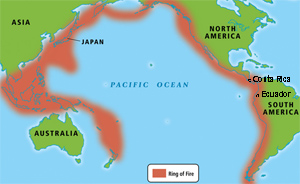 |
At four days after the incident, emergency workers were still pulling living people from the rubble. Within two weeks, the death toll in Ecuador had risen to over 650, injuries numbered in the thousands and many thousands more were made homeless. And there are dozens of people still listed as missing.
Damage is too extensive to believe early estimates but it's clear that it will require an infusion of cash and help well beyond the capability of the current Ecuadorian government's treasury and other resources. A number of Latin American countries are coming to the aid of, or pledging support to Quito.
One of the areas hardest hit was the city of Manta, a coastal town of over 200,000 people and which appears to be some 30 miles south of the epicenter. Another ROMEO and I had done some research about Ecuador after International Living magazine had ranked the country ahead of Costa Rica as a popular ex-pat retirement place. We decided against it for a couple of reasons, the biggest being the inability of a newly emigrated, +65 ex-pat to qualify for the national health system. Another drawback was considerably colder Pacific water there as a result of the Humboldt current coming up the South American coast (see the IL link above for a full comparison). But the town and coast were attractive from a distance.
The Ecuador terremoto was not the only one happening in April as, shortly before it happened there, two serious quakes occurred in Japan that killed almost 50 people. The one thing that these two occurrences had in common is that both countries are situated on the Pacific "Ring of Fire" (see diagram , above left), albeit thousands of miles apart.
We give our condolences to our brothers and sisters in Ecuador and wish them a speedy recovery.
April Nostalgia. It just so happened that April 22 was the also the 25th anniversary of the strongest earthquake in Costa Rican history, the 7.8R shaker that hit and destroyed much of Limon on the caribbean coast in 1991. The quake killed 48 people, made over 7,000 homeless and destroyed roads not just in Limon but in many parts of the country as well.
Limon Railroad 1991 Earthquake
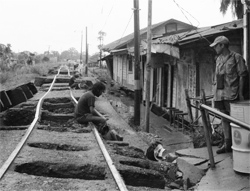 |
Many bridges were also destroyed including the one at the border crossing at Sixaola south of Limon. Not only roads but railroads were virtually destroyed (see photo right) over many parts of the country. Remember, Limon to San Jose as the macaw flies is only about 115 km (69 miles) and the entire caribbean coast, as the seagull sees it, is about 175 km (105 miles) long. The 1991 tremor was easily felt in the capital and caused minor damage there.
It's not all about the "R" rating amigos. The amount of damage and fatalities resulting from a quake is also dependent on distance from the epicenter and what kind of construction is prevalent in an area. The third largest earthquake in Tico history was in 1910 in Cartago and came in at 6.4R but killed over 700 people while the 7.0R shaker in Haiti in 2010 killed almost 250,000 people. The differences in large losses in both these instances was largely due to adobe construction which buries people when it collapses.
Contrast those losses with the second largest earthquake in Costa Rica's history, a tremor which GG had the distinct honor and displeasure of being in the middle of (i.e., less than 20 miles from the epicenter) on March 5, 2012. To read about that go here: Terremoto Terror. The 10-story hospital I was sitting in has since been razed to two stories when the upper floors were found to be irreparable. The other incredibly fortunate circumstance surrounding that tremor was that there were no fatalities and only minor injuries, some of which is attributable to much better construction standards instituted after the Limon quake.
Check Out Recent Earthquakes Around the World
Posted by the U.S. Geodetic Survey: Today's Quakes |
Search the Golden Gringo Chronicles Archives for Topics That Interest You
You can use our Archives to explore over 180 feature articles of the Golden Gringo Chronicles plus find Broken News items and ROMEO restaurant reviews. Enter your topic or item to search for in the Google Search Routine below and follow the links offered from the search results. Suggestion: Enter only a simple and precise keyword or two in order to narrow the number of references retrieved:
Golden Gringo Chronicles - Enter Search Here
¿Que Es Eso? Department
(What is This?)
 That's one hairy dude and many of you will know what it is, but how and why GG ran across it (not literally) is the real story.
That's one hairy dude and many of you will know what it is, but how and why GG ran across it (not literally) is the real story.
What do you do when encountering something like this.
Answer in What's-in-a-Word section below.
Uber Gets Some Competition
(New Outfit Details Code of Conduct)
 The Chronicles has been watching the rise of the Uber private taxi phenomenon as it develops here in Costa Rica. The start-up was rocky to say the least as the company's business model was based on no need for operating licenses nor regulation as it was simply a "private" transportation company. Yet the government viewed it as an illegal operation.
The Chronicles has been watching the rise of the Uber private taxi phenomenon as it develops here in Costa Rica. The start-up was rocky to say the least as the company's business model was based on no need for operating licenses nor regulation as it was simply a "private" transportation company. Yet the government viewed it as an illegal operation.
But the government never did come down hard on Uber (they impounded a couple of cars for show) citing the increased employment the new company was providing. Might the government also have wanted to shake up the current, rather staid, monolithic and sometimes corrupt taxi industry here to provide improved service? Competition has a way of doing that. But GG wondered how long it would take for a local operation to duplicate the Uber business model and offer some competition of its own back to Uber.
Taxis de Costa Rica
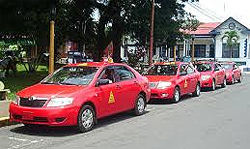 |
Not very long as it turns out. A new company in San José, Taxis de Costa Rica, based on traditional taxis (those are the red ones with the yellow triangle on the side), is hoping to compete with Uber and offer its own version of a modern, technology driven taxi company. They are working with a local tech company to develop an app similar to what Uber uses. (We do have some pretty good software capability around the Central Valley, amigos).
While the tekkies are working on the application refinements, the new company also has developed a code of ethics or customer service standards that they call their "19 commandments that include excellent personal presentation, customer respect and the use of calibrated taxi meters". Only drivers that agree to abide by the new, written standards will be hired, or at least that's the implication.
Here's a summary of the 19 commandments and sorry, I couldn't resist adding the editorial comment:
- Excellent personal presentation

- Courtesy and respect for the user
 (You guys got something against the term "customer"?)
(You guys got something against the term "customer"?)
- Respect traffic signals
 (Now this is very un-Tico or even un-Florida and rather time consuming to boot)
(Now this is very un-Tico or even un-Florida and rather time consuming to boot)
- No smoking inside the cab
 (Do we really need to put this in writing; yeah, I guess we do)
(Do we really need to put this in writing; yeah, I guess we do)
- Do not use excessive radio volume
 (Now that's an unkind cut to the heart for a Tico)
(Now that's an unkind cut to the heart for a Tico)
- Do not block bus stops
 (But dude, that's where the would-be colectivos pick off the people who are waiting for the bus but if you're doing business by app, this is no problem)
(But dude, that's where the would-be colectivos pick off the people who are waiting for the bus but if you're doing business by app, this is no problem)
- Use calibrated taximeters
 (So who's going to do the calibrating?)
(So who's going to do the calibrating?)
- Check that there are no customers belongings (left in the cab)
 (GG believes this will have a dramatic negative effect on the Costa Rican used goods after-market)
(GG believes this will have a dramatic negative effect on the Costa Rican used goods after-market)
- Seek out the shortest, quickest routes
 (Those two terms used together are an oxymoron in most cities around the world, but it would be nice to go from the Coca-Cola to the Teatro without a tour of Uruca along the way)
(Those two terms used together are an oxymoron in most cities around the world, but it would be nice to go from the Coca-Cola to the Teatro without a tour of Uruca along the way)
- Do not talk on the phone while driving
 (We have bus drivers in Quepos that can talk on the phone, drive curves and make or stack up change all at the same time - beat that Taxistas)
(We have bus drivers in Quepos that can talk on the phone, drive curves and make or stack up change all at the same time - beat that Taxistas)
- Maintain silence during the journey
 (¡jueputa! I like to engage the driver in conversation - that's how I practice my Spanish, amigo)
(¡jueputa! I like to engage the driver in conversation - that's how I practice my Spanish, amigo)
- Use business cards
 (Why, if I'm going to call an app?)
(Why, if I'm going to call an app?)
- Having money for change
 (No changey, no tippy)
(No changey, no tippy)
- Keep units (cabs) clean
 (Inside and outside amigos. the non-smoking rule helps here)
(Inside and outside amigos. the non-smoking rule helps here)
- Do not ask where the user is going before the user mounts the taxi
 (Why would you need to if we've already agreed by app? I don't mount a taxi, I enter it)
(Why would you need to if we've already agreed by app? I don't mount a taxi, I enter it)
- Always use the taximeter
 (Again, if it's like Uber, we have pre-agreed on a rate with the app, you really don't need the Maria anymore, senor)
(Again, if it's like Uber, we have pre-agreed on a rate with the app, you really don't need the Maria anymore, senor)
- The taximeter should be in a visible place
 (Again, if we pre-agreed on a rate with the app you can put the Maria in the trunk for all I care)
(Again, if we pre-agreed on a rate with the app you can put the Maria in the trunk for all I care)
- Do not use selected fares (i.e., discriminate against short or out-of-the-way trips)
 (Again, we pre-agreed on a rate with the app and this one also seems like a full duplicate of #9)
(Again, we pre-agreed on a rate with the app and this one also seems like a full duplicate of #9)
- Being a friend of the customer, never an enemy
 (¡Todos los costaricences son mis amigos! I do very little business with enemies)
(¡Todos los costaricences son mis amigos! I do very little business with enemies)
 I would offer #20: let's keep it simple amigos; I could re-write the 19 commandments above into a more standard and memorable ten.
I would offer #20: let's keep it simple amigos; I could re-write the 19 commandments above into a more standard and memorable ten.
Get the phone app developed first amigos, then we'll talk. Call me if I can be of help.
P.S. GG was in San José for a couple of days at the end of April and decided he would try Uber, especially because, after the sign-up and app download, they sent me a 5,000 colones coupon for the first ride. However, it was not to be this time. I got the app to recognize (by auto-gps) where I was in Escazu but it would not accept my destination (Tracopa Bus Station) despite trying 1) Tracopa Terminal, 2) Términal Tracopa, 3) Tracopa, 4) 18th avenue and 5th street, or 5) avenida 18 y calle 5.
I'm having an email discussion with Uber at this time but have not learned why it didn't work (or if and how I screwed up). There will be more to report later. I took two busses to get to Tracopa (at least the price was right - 0 colones for an old fart with a cédula).
¡Solo Bueno!
TOP
Robot Infatuation
(Version 2.0)
There's getting to be an app for everything. One M.D. on television (Dr. Manny on Fox) features a new medical app for your I-phone almost on a daily basis. Technology is dominating our lives whether we like it or not. I'll leave it to the two-cent philosophers to argue whether that's a good thing or not but my view is that it's not the technology that's the problem, it's the fallible humans employing it that causes difficulty.
But GG will readily admit to a fascination (obsession?) with robot technology. Every day we see new incredible robot products being developed and at an equally incredible pace. The Chronicles first reported on this phenomenon in Robot Mania where GG introduced Chronicles readers to an attractive, life-like babe named Nadine (who, by the way, still hasn't sent me her IP address).
Now let's see if we can visualize the future for a business person; the near future that is. Pretend you're the businessman (could be a businesswomen, of course) in the following story. The year is 2025, only nine years away:
GG's Stretch Airport Limo
Now That's a Ride!
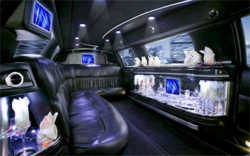 |
You arrive in downtown San José from Juan Santamaria airport, in a comfortable, sleek and clean, air conditioned limousine (Taxis de Costa Rica or Uber) sipping a complimentary Stoli martini or passion fruit smoothie (your choice) from the auto-bar. This vehicle is not a colectivo, amigos. You have been self-driven by the limo for 20 kilometers in heavy traffic but it's taken only 12 minutes because there are special lanes on the autopista reserved for vehicles like yours and all vehicles are properly spaced and velocity-optimized by computer.
The limo waiting for you at the airport buzzed your K-Phone (+2 generations) as to its location and led you to it. As you entered the car, a short recorded message was announced to you that the Uber driver had been replaced by Claude, the latest Uber behind-the-dashboard computer. In addition to piloting the vehicle and constantly monitoring the flow of traffic along the route, Claude is capable of offering an almost endless number of suggestions on any location, restaurant, cultural activity or event happening today or in the next six months in any part of Costa Rica.
Doorman Barkley
 |
"Claude, a question, is the Costa Rican national team playing a world-cup qualifier this week?" "Yes, sir, Wednesday night at 20:00 hours, er 8 PM; excuse me sir I forgot for a moment that you're from Boston. The Ticos, coached by Keylor Navas will be playing the CONCACAF-leading United States in what should be a real steamer. Can I order tickets for you sir?" "Yes, two please, Claude".
Five seconds later: "You have two center field tickets at the National Stadium, tenth row up, the best I could do; is that satisfactory sir?" "That's fine Claude". "Very good sir, your credit card ending in 7855 has been charged for $112.50 and the tickets will be waiting at the stadium ticket office." "What else can I help you with sir?" "Nothing at the moment, thank you Claude." "My pleasure sir." (The taxi company will receive an $15 spiff on the ticket purchase.)
The limo pulls up to the plush entrance to the Golden Gringo Excelsior hotel two blocks from the Teatro Nacionál, the passenger door opens and you are greeted by Barkley, the Excelsior's robot doorman (version 3.1) who has a remarkable resemblance to Ryan Gosling. "Good afternoon, Mr. d'Oro, it's nice to have you back with us, it's been too long, almost a year." Barkley can remember, through face recognition, and scanning Mr. d'Oro's residual fingerprint from the taxi door handle, virtually all customers and visits since the hotel was opened in 2020. "Can I do anything to help you Mr. d'Oro?" "Not at this time Barkley, thank you." "You're very welcome sir". (Don't you love the way robots can not be indifferent or impolite?)
Mariposas
 |
Walking through the electronic door, the presence of Mr. d'Oro is confirmed in the hotel's artificial intelligence system (A.I. computer). There is no reception check-in, it's not needed. Almost at the same time a beautiful young woman comes walking over to Sr. GG d'Oro. This is one of the two lobby hostesses who goes by the name of Mariposas (v 2.8) and who is modeled after the former Miss Costa Rica, Fabianna Granados.
"Great to see you again Mr. d'Oro. Your room is 2716 and the door is now programmed to open with the touch of your forefinger." "Is there anything I can help you with?" "Great Mari, yes there is. (They had become chummy on GG's last visit, she becoming Mari to him) I would like to take a simple dinner in the room about 7 PM, let's say a tuna steak, rare with green peppercorns and that special tamarindo sauce on the side. Add braised veggies etc." Excellent choice Mr. d'Oro, may I suggest a special tres leche topped with sliced almonds and a mora sauce for dessert? I would also suggest a half bottle of our light Chilean Alta Tierra Syrah that will go well with both the fish and dessert?" "All good Mari; you remembered how much I liked that wine from last time." "That's my job sir and have a great evening."
In his room, Senor d'Oro found his bag already deposited by the auto-porter that had picked it up at the limo. After being welcomed by the A.I. speaker from the in-room computer portal (which he named for this visit on first contact, Ralph), he elected to refresh himself with a shower. "Would you like the same temperature and shower massage settings for the shower head you used last stay, sir?". Yes, Ralph". Afterwards he took a peaceful nap of almost an hour, declining a therapeutic massage by the hotel therapist (Karl - v1.9), the first Internationally ITEC credited and licensed android massage therapist who was originally developed in Switzerland.
Henn-na Hotel, Sasebo, Japan
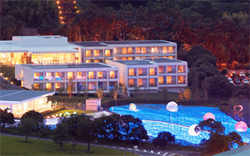 |
At 6:45 GG was gently awakened by soft Vivaldi background music and Ralph whispering: "Mr. d'Oro, it's 6:45 sir." This gave GG time to dress and be ready for dinner which arrived at the room with the hotel auto-porter precisely at 7:00 as requested.
Is all this just a lot of sci-fi, futuristic stuff? Not really, much of it is already happening in many places. Leave it to the Japanese to be at the cutting edge of this movement. They already have a sleek, modern hotel, the Hotel Henn-na in Sasebo, Japan (about 50 km/30miles) north of Nagasaki, totally run by robots. Read the description of their hotel in their own words:
Auto-Porter
(I Think the Lady is Real)
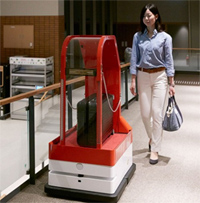 |
Toshiba Reception Robot Chihira Kanae
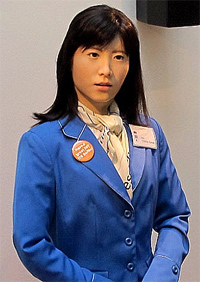 |
"At the front desk, you will be greeted by multi-lingual robots that will help you check in or check out. At the cloakroom, the robotic arm will store your luggage for you, and the porter robots will carry them to your room. Mechanic yet somehow human, those fun moments with the robots will warm your heart. Furthermore, once you register your face with our face recognition system, you will be free from the hassle of carrying the room key around or worrying about losing it."
The Henn-na Hotel front desk ("Konnichiwa, GGsan") is "manned" by three robots, two of which are human like and the third, perhaps for the kiddies in us all, is a dinosaur. Toshiba also has a reception robot named Chihira Kanae that can speak 19 languages and is already staffing a hotel in Berlin.
In Ghent, Belgium a smaller, more robot looking little metal and plastic man named Mario has been working since mid-2015. He also speaks 19 languages and is charged with "guarding the buffet". (So what happens when you take a few too many cold cuts, Mario?) And there are other robot locations: a) an IBM powered humanoid robot is acting as concierge at the McLean Hilton in Virginia, b) Royal Caribbean Cruise Lines now has robot bartenders on several of it's ships (I wonder if they're authorized to give a freebie now and then?).
This whole thing looks like the wave of the future but amigo, the future is now. It's too early to answer the question of whether or not the public will accept all this but I suspect the droids will at least be a big hit with the crowd that loves theme parks.
I still think my models for doorman and receptionist are better that Toshiba's and Honda's. I wonder how long it will take movie stars to realize they could be getting substantial royalties by franchising their looks directly; after all isn't that what Hollywood is all about?
¡Pura Vida!
TOP
Lady Soldier of Costa Rica
(Move Over Juan Santamaria)
April 11 is a national holiday in Costa Rica, popularly known as Juan Santamaria Day.
Juan Santamaria Statue
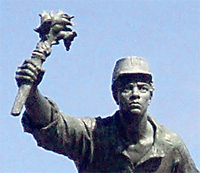 |
You may recall that Juan Santamaria was a 25 year old soldier who distinguished himself in the Battle of Rivas (Nicaragua, April 11, 1856) against that rogue American adventurer and "filibuster" of the time, William Walker.
Juan and the Costa Rican army (they had one at that time) routed Walker's "army" and sent him retreating north. Subsequently, the British caught up with him in Honduras and hanged him. So much for that Philadelphia lawyer.
Unfortunately, Juan Santamaria lost his life in that battle. The main international airport of San Jose, located in Alejuela, is named after Juan. Every Costa Rican is likely to know who Juan Santamaria was and what he did for the country but there was another hero(ine) of the Battle of Rivas that is less well known.
Pancha Carrasco
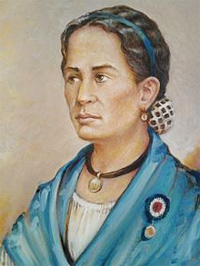 |
Her name was Natalicio Francisca Carrasco Jiménez but was better and more affectionately known as Pancha Carrasco. (Pancha is the feminine version of Pancho, the meaning of which is explained in the What's-in-a-Word section below). She has been likened to be the Molly Pitcher of Costa Rica. Molly (probably a lady named Mary Hays) was the folklore hero of the American Revolutionary War who reportedly carried pitchers of water to the troops even under heavy fire.
Pancha Carrasco went Molly one further; she picked up a gun and joined the fight in Rivas. She had originally joined the Costa Rican army as a cook. In those days that meant joining the troops in a long march to the border and Rivas and reconstructing a kitchen each day to service the troops. She was about 40 years old when she did this.
This was one busy lady. During her lifetime Pancha managed to be a widow twice and marry three times. She learned to read and write even though women were not allowed to go to school at that time. These were turbulent times and before Rivas, she took to horse and incited a revolution against General Francisco Morazan, a "warlord" who lead forces dedicated to joining a part of Nicaragua with Guanacaste. She was important to the eventual collapse of Morazan and his followers, leading to the stability of the Costa Rican government under President Juan Rafael Mora Porras, who is considered the father of the first republic and who led the country into Rivas to stop Walker and his boys.
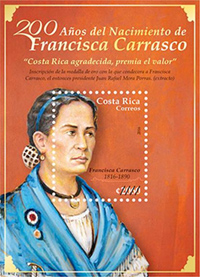 During the battle of Rivas, Pancha Carrasco took up a rifle and fought along side the regular troops. She is credited with being responsible for capturing an enemy cannon and turning it on the invading filibuster forces. That night, Juan Santamaria snuck into the camp of the filibusters and lit the enemy barracks on fire, killing several, disrupting the forces, turning the tide of battle and getting himself killed in the process.
During the battle of Rivas, Pancha Carrasco took up a rifle and fought along side the regular troops. She is credited with being responsible for capturing an enemy cannon and turning it on the invading filibuster forces. That night, Juan Santamaria snuck into the camp of the filibusters and lit the enemy barracks on fire, killing several, disrupting the forces, turning the tide of battle and getting himself killed in the process.
During this campaign, Pancha was also in the midst of a devastating cholera epidemic that broke out among the troops during the campaign. Eventually, she returned with the victorious troops to San José and was decorated along side other soldier heroes.
Carrasco died in 1890 at the age of 74, in poverty, receiving 15 pesos a month as a pension (don't ask - I have no idea of what value that is today, probably very little). After her death she received military honors including the rank of Major General (she probably could have used that title better when she was alive to get a bigger pension). In 1994 she was declared "A Defender of the Country's Freedoms" and on March 8, 2012 she was declared a National Heroine. On the same day, the office of the President of the Legislative Assembly was renamed "Pancha Carrasco". More recently, on the 200th anniversary of her birth, a postage stamp was issued in her honor (above, left).
The lady, like Juan Santamaria, was a true hero of the republic. ¡Que buen trabaja, Pancha!
¡Solo Bueno!
TOP
Travel Quote of the Month
Part of a Flight Attendant's arrival announcement: "We'd like to thank you folks for flying with us today. And, the next time you get the insane urge to go blasting through the skies in a pressurized metal tube, we hope you'll think of us here at US Airways." |
What's-in-a-Word
Answer to ¿Que Es Eso?
 The answer is not that it's a sloth; no the answer is that it's a three-toed sloth. These dudes come in two and three toed varieties and the "toes" are really claws which you won't forget if the owner decides to scratch you. I'm told that the 2-toed version can be much more aggressive than the 3-toed. I've also heard that they're not the cleanest of animals and often harbor ticks and other insects in their fur. Therefore, handle with caution.
The answer is not that it's a sloth; no the answer is that it's a three-toed sloth. These dudes come in two and three toed varieties and the "toes" are really claws which you won't forget if the owner decides to scratch you. I'm told that the 2-toed version can be much more aggressive than the 3-toed. I've also heard that they're not the cleanest of animals and often harbor ticks and other insects in their fur. Therefore, handle with caution.
I had just gotten off the bus at the Mono Azul stop in Manuel Antonio and was walking up the street known here as the old road to Quepos when I nearly stumbled across this dude very slowly lumbering across the road. I decided to stand guard over him against passing traffic but wondered - how can I help him as the side of the street he was headed for is populated with houses? I can speak a little Spanish but very little Sloth. I don't even know how to pick one up.
Smile, Folks!
 |
Just then a middle-aged Tico came along, stopped his car, got out and smiled at the perplexed dummy gringo who didn't know what to do. He walked over to the sloth and gently picked him up by the scruff of fur on his back, turned him 180 degrees and slowly returned him to the wooded side of the road into a pile of leaves. The Tico got back into the car, smiled once more, this time with the that's-how-you-handle-a-sloth look behind the smile and left. The sloth looked back at me once with that perpetual smile they all have, then slowly headed back into the forest. Everybody had smiled including me.
I named this sloth Shiloh because in Hebrew that means "The peaceful one, he who is to be sent." (Not that I'm a student of Hebrew, I just looked up s-names and thought the description fit his demeanor and condition).
Now I know the basics of a close encounter of a fourth kind; with a sloth.
Papagayo
Used in Costa Rica in the northwest, it's often to describe high, dry winds. My dictionary tells me it also means 1) a parrot, 2) a chatterbox, 3) a bedpan or 4) a kite. See, I told you Spanish was versatile.
Bomberos
A bombero is a fireman. When referred to in plural, it's the fire brigade. Of course, you can also be a firewoman, a bombera.
Pancho/Pancha
Pancho is a nickname for Francisco (therefore, Pancha is also a nickname for Francisca).
When used as an adjective, this means calm, unruffled, unworried or satisfied. Funny, I never thought of Pancho Villa, the Mexican revolutionary that way. He was known as Francisco Villa but his real full name was José Doroteo Arango Arámbula - go figure.
Used as a masculine noun it can also mean hot dog (in the Rio Plata, Argentina), a chorizo (sausage) sandwich (in Paraguay) or making a scene or fuss (in Mexico - now that fits Pancho Villa better
.
Pancha, or course, is just the feminine of pancho, hot dog or not. Ole!
TOP
ROMEO Corner
(Retired Old Men Eating Out)
Buena Vista del Mar at Tulemar, Manuel Antonio
Location: Top of Manuel Antonio between Escuela D'Amore and Salsipuedes
Hours: Breakfast, Lunch and Dinner Monday through Sunday
Parking: Limited near the restaurant - street parking outside reception is also limited.
Contact: All Restaurant Info is via the Tulemar Bungalows Reception Center: Tel. 506-4001-5878; Email: reservations@buenavistaluxuryvillas.com; Website:http://www.4tulemar.com/
Reviewing ROMEOS: Anita M., Bob N., Brian M., Chris H., Davis H., Sari H., Stef C.
To Review Our Rating System and Procedure, go here: R.O.M.E.O. Rating System
Tulemar Condominios has a good reputation in the community for luxury bungalows. It is both a community of property owners and renters with its own private beach. You wouldn't know there's a restaurant there because the entrance to the complex is so unobtrusive, almost hidden.
Sunset View from Tulemar Restaurant
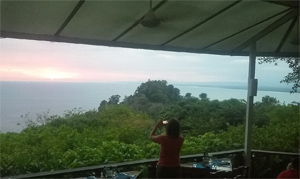 |
The property runs in a wide swath from the main Manuel Antonio road all the way down to the beach. The restaurant is normally accessed through the reception area located on the MA main road. From there, a van sweeps you about half way down the hill to the restaurant.
The view from the restaurant is exceptional even by MA standards, capturing the Pacific in front and the northern coast running all the way up to the rocky point just below Jacó. Positioned dead center (at least at this time of year) was the sunset.
The restaurant is arranged and decorated with what I call "Classic MA", namely wide use of wood furniture, simple table decor and plain (but cloth) napkins and silverware. The chairs had some padding on them (GG is grateful for that as unpadded wooden chairs are often a pain in his tuchas). The overall effect is to feel easily and quickly comfortable.
Our composite score for Atmosphere by the seven ROMEOs attending was 4.7 out of 5 sloths.
The menu had a larger than average selection of appetizers and main courses as well as a couple of specials. I notice an Argentine beefsteak that will have to be tried another time as I moved on to one of the night's specials. We were first served a small complimentary bruchetta and one of the ROMEOs supplied the group with a cabbage slaw starter. After that I tackled an appetizer of what was described as a tempura shrimp and seafood combination. What I got was closer to a heavily breaded shrimp which was tasty nonetheless and served with a tangy red sauce. The amount was so large I had to ask three other people to share it with me.
Several of us took advantage of the ribs special that evening which consisted of a small rack of the baby-back variety doused in a tasty barbecue sauce and accompanied pinto beans also in the barbecue sauce. Although I love the large Costa Rican version of ribs, "costillas", I welcomed the brief moment of nostalgia having U.S. ribs.
Other dishes ordered by the ROMEOs included an assortment from fish to pasta with shrimp. All diners pronounced their food delicious.
Three of us ordered dessert and the most interesting one was labeled bananas foster but actually included mango as well and was served on a very nicely decorated plate.
|
 |
.jpg) .6 .6 |
$$$$ |
Value Index = 115 |
The composite score for food quality was also 4.7 sloths. (Although our group didn't use it, I did notice a rather nice selection of Chilean and Argentine wines on the rack)
ROMEOs Hard at Work at Tulemar
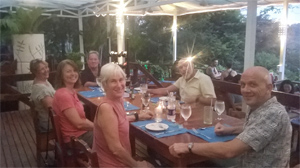 |
Service by Harley our waiter was attentive, helpful and friendly. Several of us had run across Harley before in other restaurants; we're one, big happy family here. The composite score for service was 4.3 sloths giving an overall score for ambiance (that's an uptown word for atmosphere), food quality and service of 4.6 sloths.
My bill for the large shrimp appetizer, ribs and two coca lights (diet cokes) was $43.05 (the menu is all priced in US$ so conversion wasn't necessary. As usual most of the others had somewhat smaller bills and our composite score for cost came in at 4.0. That yields a value index of 4.6/4/0=115 and puts the restaurant in the top third in the area for value.
All together the ROMEOs found Buena Vista del Sol a pleasant dining experience.
Here are some of the ROMEOs written comments left behind: "Very good overall", "Enjoyed the Ribs", "Harley was very knowledgeable, helped me pick my meal and the cabbage crunch appetizer was so delish", "Had to ask 2x for the second drink of my happy hour 2x1" (guess that's how the service ranking went down to 4.3 - ed.)
Golden Gringo Chronicles Novel and E-Books Now Available!
 The story of the Golden Gringo Chronicles is also available as a hard copy novel of 192 pages available through Amazon and all major online retailers. ($9.95) Amazon link: GGC, the Book. (Kindle Edition available)
The story of the Golden Gringo Chronicles is also available as a hard copy novel of 192 pages available through Amazon and all major online retailers. ($9.95) Amazon link: GGC, the Book. (Kindle Edition available)
Follow GG through the first six years of his odyssey in making the decision to retire in Costa Rica, overcoming the trials and tribulations of moving and obtaining residency there and the fun and experience of actually living in Ticoland.
Ride along with the Golden Gringo as he learns about the rich, varied culture of Costa Rica, the incredible bio diversity, the charming nature of the Costa Rican people and the ease with which a sometimes clueless ex-pat can assimilate into a small southwestern town on the Pacific coast.
Whether you are already a Costa Rican resident, someone contemplating a move here or just a traveler who enjoys different cultures, you will find the Golden Gringo Chronicles interesting, entertaining and informative about Costa Rica.
A narrative version of the Golden Gringo Chronicles is now also available as a trilogy of E-books in formats compatible with virtually all electronic platforms.
Part 1: (FREE!)
Leaving the Homeland
Part 2: ($3.99)
The Early Years
Part 3: ($3.99)
Becoming Tico, Maybe
Click on Part Number above for E-book sample downloads or click the price above right for purchase. (The best price is on Part 1; it's FREE)
Opt-In Here to Receive Your Free Copy Monthly
The Golden Gringo Chronicles is a free newsletter that is non-political, non-commercial and, hopefully, entertaining. By signing up you will receive an email each month around the first of the month giving you the links to the latest edition as well as to each individual feature and departmental section.
CLICK HERE TO SIGN-UP FOR THE
GOLDEN GRINGO CHRONICLES
or Email me at gg@goldengringo.com
Website: www.goldengringo.com

The Golden Gringo
Pura Vida!
To Contact GGC World Headquarters (yuk, yuk) to make comments, suggest topics or criticize my bad jokes, just send an email to: gg@goldengringo.com.
Be pithy but kind; I'm sensitive.
Unsubscribe from Golden Gringo Chronicles











 An interesting report came out recently about Metformin, a drug used to control sugar level in Type II diabetics like yours truly.
An interesting report came out recently about Metformin, a drug used to control sugar level in Type II diabetics like yours truly.





 That's one hairy dude and many of you will know what it is, but how and why GG ran across it (not literally) is the real story.
That's one hairy dude and many of you will know what it is, but how and why GG ran across it (not literally) is the real story. The Chronicles has been watching the rise of the Uber private taxi phenomenon as it develops here in Costa Rica. The start-up was rocky to say the least as the company's business model was based on no need for operating licenses nor regulation as it was simply a "private" transportation company. Yet the government viewed it as an illegal operation.
The Chronicles has been watching the rise of the Uber private taxi phenomenon as it develops here in Costa Rica. The start-up was rocky to say the least as the company's business model was based on no need for operating licenses nor regulation as it was simply a "private" transportation company. Yet the government viewed it as an illegal operation. 
 I would offer #20: let's keep it simple amigos; I could re-write the 19 commandments above into a more standard and memorable ten.
I would offer #20: let's keep it simple amigos; I could re-write the 19 commandments above into a more standard and memorable ten.







 During the battle of Rivas, Pancha Carrasco took up a rifle and fought along side the regular troops. She is credited with being responsible for capturing an enemy cannon and turning it on the invading filibuster forces. That night, Juan Santamaria snuck into the camp of the filibusters and lit the enemy barracks on fire, killing several, disrupting the forces, turning the tide of battle and getting himself killed in the process.
During the battle of Rivas, Pancha Carrasco took up a rifle and fought along side the regular troops. She is credited with being responsible for capturing an enemy cannon and turning it on the invading filibuster forces. That night, Juan Santamaria snuck into the camp of the filibusters and lit the enemy barracks on fire, killing several, disrupting the forces, turning the tide of battle and getting himself killed in the process.  The answer is not that it's a sloth; no the answer is that it's a three-toed sloth. These dudes come in two and three toed varieties and the "toes" are really claws which you won't forget if the owner decides to scratch you. I'm told that the 2-toed version can be much more aggressive than the 3-toed. I've also heard that they're not the cleanest of animals and often harbor ticks and other insects in their fur. Therefore, handle with caution.
The answer is not that it's a sloth; no the answer is that it's a three-toed sloth. These dudes come in two and three toed varieties and the "toes" are really claws which you won't forget if the owner decides to scratch you. I'm told that the 2-toed version can be much more aggressive than the 3-toed. I've also heard that they're not the cleanest of animals and often harbor ticks and other insects in their fur. Therefore, handle with caution.
